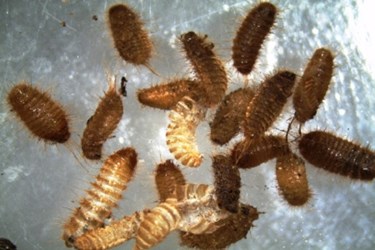A New Food Inspection Technology May Provide A Solution For Insect Detection
By Isaac Fletcher, contributing writer, Food Online

Researchers are working toward the development of an inexpensive, disposable sensor that is capable of remotely detecting insect infestations of food shipments without the need for visual inspection.
When it comes to the agriculture industry in the U.S., invasive insect species pose a significant threat. In order to effectively guard against losses from insects, it is important to ensure that known invasive species are detected and their introduction is avoided along global trade pathways.
One such threat, the khapra beetle, has proven to be exceedingly difficult to control. The beetles can survive nearly anywhere and are resilient to cold temperatures. Additionally, the damage caused by the khapra beetle larvae is worsened by their “dirty eating” behavior wherein the larvae eat only a small portion of a single grain before moving on to others. Not only do the beetles destroy crop stores, they present a food safety hazard as well. The larvae hairs and cast skins can potentially cause allergic reactions and respiratory issues, especially among young children.
The khapra beetle is the only stored product pest that has earned a quarantine status in the U.S. It is also the only pest that can cause import shipments to be rejected based on the presence of non-living life stages, such as cast skins or other insect parts.
The Department of Homeland Security (DHS) Customs and Border Protection Agriculture specialists are required to target imports from countries with a known khapra beetle population, open shipping containers, and visually examine the commodities for evidence of infestation. Considering the fact that the beetles are no larger than a grain of rice, this is a very difficult and time-consuming task.
To help address the khapra beetle issue, Edgewood Chemical Biological Center (ECBC) is working alongside the DHS Science and Technology Directorate (S&T) and the U.S. Department of Agriculture (USDA) to create better, more-effective measures of inspection. The project is funded by the DHS S&T, and ECBC researchers, partnered with iSense, LLC, are exploring the use of colorimetric sensor arrays (CSA) to detect invasive species in shipping containers.
The sensors, which are inexpensive and disposable, are about one square inch in size. They are spotted with 73 dyes that change color when various vapors come into contact with the CSAs from the sample. A sample can then be identified based on the combination of color changes across multiple spots that forms a “fingerprint” used to identify the compounds in a sample.
The color changes are sensitive enough to detect even trace amounts of some vapors, which allows for the broad spectrum detection of a variety of volatile organic compounds (VOC), even when they are well below dangerous concentration levels. As compounds and their respective CSA color signatures are identified, they can be indexed to create a reference library.
The project’s mission is to develop unique and individual spot patterns that can be used to discern between invasive khapra beetle infestations and other, non-invasive species. If infestation is detected within a closed container, the cargo can be sequestered before being opened, mitigating the risk of further exposure. If the project is successful, the technology could be leveraged to create self-contained sampling and detection units that could wirelessly transmit results to a smartphone for analysis. ECBC project lead, Jeff Ballin, Ph.D., says, “Our vision is to create remote interrogation of shipping containers that reduces the burden on the customs officials.”
The first step in creating this solution is the development of a reproducible signature library that can differentiate between beetle-infested grain and pristine grain. Due to the fact that khapra beetles are quarantined, researchers have used the common warehouse beetle, which is closely related to the khapra beetle, for testing. Although the project is still in its infancy, researchers have been able to successfully distinguish between infested and clean grain based on the use of CSAs. The first round of testing is expected to be complete this autumn.
